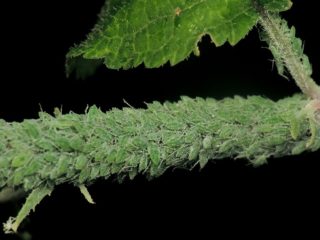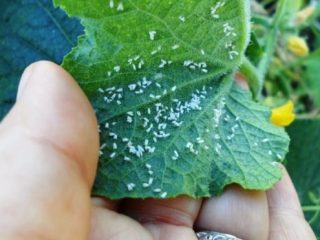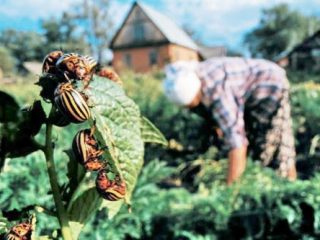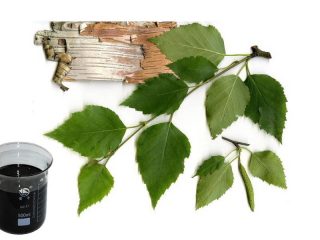Content
When growing petunias, the grower may face various problems, for example, chlorosis. This disease has different causes, but in any case, it harms plants. Information about what causes petunia chlorosis and how to deal with it will come in handy for those who are growing seedlings or adult plants.
What does chlorosis look like in petunia and what is dangerous
Healthy specimens have green or dark green leaves and stems. The characteristic signs of the disease are the gradual yellowing of the leaf blades, while the veins of the leaves remain in their natural color. Over time, they twist and die off, new ones grow small, the tops dry out. Chlorosis can also affect the root system. Growth and development slow down, and if not taken action, it can die.
The disease can affect both seedlings and adult plants, that is, it can be encountered at any period of their growing season. How chlorosis of young seedlings of petunias looks like can be seen in the photo.
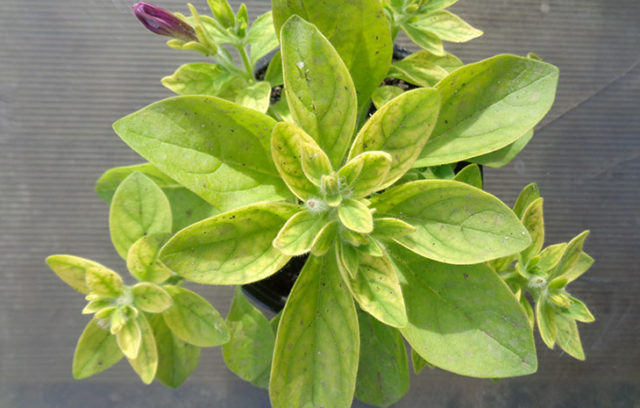
Chlorosis usually affects young leaves first.
Chlorosis types
This disease causes a disruption in the formation of chlorophyll in leaf cells, which inhibits photosynthetic processes. The plant cannot produce important substances for itself, which affects its development and growth. Chlorosis cannot be considered a harmless disease. Without treatment, petunias, especially young ones, can die.
Chlorosis is infectious, caused by microorganisms, viruses and fungi. Pathogens enter plants through damage from pests. This type of disease occurs in petunias, but not as often as functional.
Reasons for the appearance
Functional chlorosis is the result of an imbalance in the balance of mineral elements in plant tissues, especially iron, magnesium, nitrogen, zinc, and proteins. The reason may be a deficiency of these components in the ground or a shift in the acidity of the soil towards an increase or decrease, which makes the elements inaccessible for absorption by the roots, even if they are in the soil. In most cases, this petunia disease is caused by just such reasons.
Treatment of chlorosis of petunia must begin with establishing which element is missing in the soil or with determining acidity. The reason for the deviations is most often the incorrect use of fertilizers. Many widely used top dressing, for example, ammonium nitrate, carbamide, superphosphate, potassium and phosphoric ones - oxidize the soil, sodium and calcium nitrate, phosphate rock, ash - alkalize. If you get too carried away with any of them, it may turn out that the acidity will be disturbed. The same applies to trace elements, the lack of any of them can be caused by excessive or, conversely, insufficient use of certain fertilizers.
In the case of petunia seedlings and flowers growing in pots, the cause of chlorosis may be an insufficient volume of substrate in which each plant is located, excessive watering when the soil sours, and high indoor temperatures.
You should also pay attention to the water that is used to water petunias. Ideally, it should be distilled, that is, it should have a neutral reaction. Tap water is considered alkaline because of the trace elements dissolved in it. This also needs to be taken into account when trying to create optimal conditions for plants.
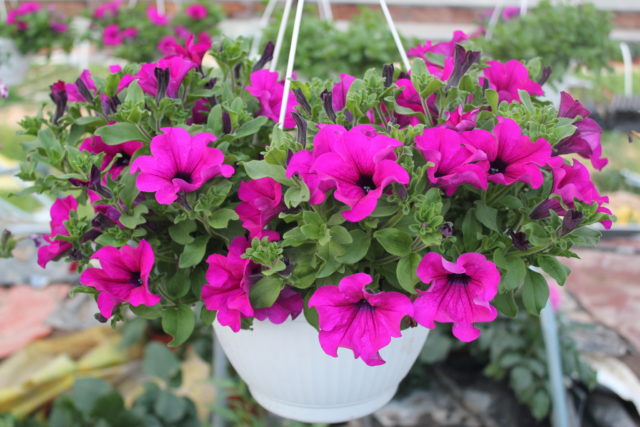
The likelihood of developing chlorosis will decrease if the petunia grows in a spacious pot.
How and how to treat chlorosis in petunia
Treatment methods are root watering or spraying with fertilizer solutions that contain the required element. Moreover, foliar application acts faster than root application, because microelements, absorbed with moisture in the leaf tissue, begin to be used by them immediately.
The best drugs for chlorosis in petunia are those in which the elements are in a chelated form. Of these, iron and other elements are absorbed faster and completely. You can buy chelates at the store or make your own. They are sold in liquid form and in a small volume, just convenient for use in the household.
An example shows how to make chelated iron at home:
- Dissolve 8 g of ferrous sulfate in 2 liters of pure (preferably distilled) water.
- In other 2 liters of liquid, dilute 5 g of citric acid.
- Iron vitriol is introduced into the acid solution, constantly stirring all the liquid.
- Add another 1 liter of ordinary water to the four obtained liters.
You get 5 liters of chelated fertilizer. The mixture should be transparent, without sediment, and have an orange color. It should be used immediately after preparation. The fertilizer must not be diluted. If more is needed, prepare a fresh batch. Homemade iron chelate is effective for a short time - its shelf life is no more than 14 days. The frequency of spraying is 2-3 times a week until recovery, then for prophylaxis - 1 time per week.
If the cause of chlorosis is in alkaline soil, which can be established after checking the acidity level, it is necessary to acidify it in order to shift the indicators in the right direction. To do this, water the seedlings of petunias or adult plants with a weak solution of citric acid. Cooking process: dissolve 3-5 g of powder in 10 liters of water and water the flowers as usual.
You can reduce acidity by using ash, phosphate rock, calcium or sodium nitrate. Prepare solutions in accordance with the concentration standards offered by the manufacturers of these fertilizers.

Chelates are the best form of fertilizer you can use to feed petunias
Prophylaxis
To prevent chlorosis in petunias, you need to choose the right fertilizers that can be used for feeding, make sure that the concentration of solutions is within the normal range. Fertilizers should also be applied according to the recommendations, not more often and not less often than it should be.
Instead of synthetic fertilizers, ash can be used for feeding, it contains almost all the necessary elements, except nitrogen.
In order to reduce the likelihood of chlorosis in petunia seedlings, you need to take care even during sowing: choose pots for plants of such a volume that they do not feel a lack of nutrients until the very transplant. Adult flowers should also not grow in small containers; on average, 1 petunia needs at least 3 liters of substrate. If the soil is depleted, you need to transplant the plants into a new potting mix and increase the volume of the pot. For irrigation, use settled tap water, well, rain or melt water. Water so that there is no stagnation of the liquid.
To prevent infectious chlorosis, you need to disinfect inventory, pots, substrate, seeds with fungicides or at least 1% Bordeaux liquid. If the disease still develops, you need to immediately shed the soil with fungicides and spray the plants at the same time. Treatments must be carried out until the moment when there are no noticeable signs of the disease on the petunias.To prevent diseases and damage by pests that can spread diseases, one must not forget to do preventive spraying with fungicides and insecticides. It is not necessary to immediately use agrochemistry, at first it is enough to use folk remedies.
Disease resistant varieties
Resistant varieties that belong to the multi-flowered group, for example, "Fantasy", "Avalanche", "Mirage", "Plumkristala". Large-flowered petunias - "Pikoti", "Hit-parade", "Pearl pirouette" are more susceptible to the disease.
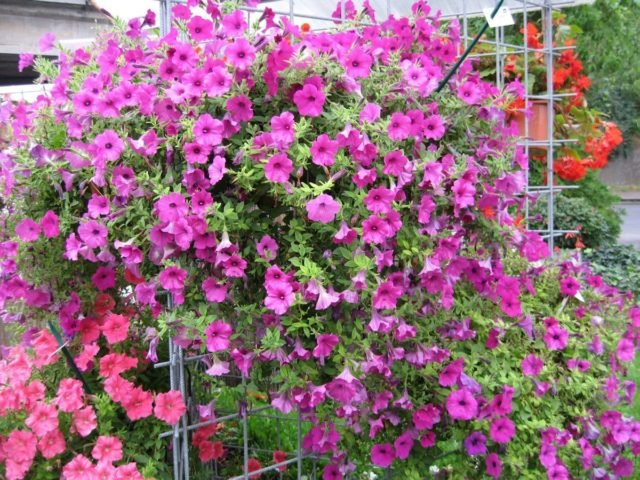
Multi-flowered petunias are considered chlorosis-resistant.
Conclusion
Petunia chlorosis can affect plants during any period of their growing season, if mistakes are made in feeding or creating growing conditions. You need to start fighting this disease after identifying the causes of its occurrence. Without help from the grower, petunias will not be able to recover on their own, which will lead to their death.





